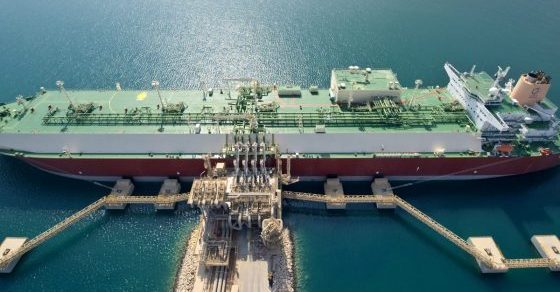The Asia Pacific area is anticipated to see the biggest increases in regasification capacity.
Qatar’s North Field will power the Middle East’s liquified natural gas (LNG) liquefaction capacity by adding 140 million tonnes per annum until 2050, a recent report has said.
From 2021 to 2050, an additional 560 million tonnes of liquefaction capacity will be available globally, according to the Gas Exporting Countries Forum (GECF) report, released on released on January 29.
This includes proposed, possible, stalled, and speculative projects as well as those that are currently under construction and in all FEED (front-end engineering and development) stages.
With an addition of almost 160 million tonnes per annum (mtpa) backed by unconventional gas, North America will contribute the most liquefaction gains. The capacity for liquefaction on a global scale increased from 270 mtpa in 2010 to 462 mtpa in 2021 and is expected to more than quadruple to roughly 1,032 mtpa by 2050.
Over 80% of the liquefaction capacity will be used by the time LNG demand reaches 850 mtpy in 2050, keeping markets well-supplied for the entire projected period.
Qatar exported 77 million tonnes in the year 2021. By 2026 and 2027, state-owned QatarEnergy seeks to boost its liquefaction capacity to 110 mtpa.
By 2050, pipeline and LNG infrastructure would both increase, GECF said in its latest “Global Gas Outlook 2050”. Through 2030, spending will be dominated by liquefaction and regasification capacity, while expansion is anticipated to decelerate after 2040.
Through 2050, there will be continued expansion of export pipelines, mainly in Eurasia and Europe. Global LNG demand is expected to more than double from 372 million tonnes in 2021 to 850 million tonnes by 2050, driven by robust demand in emerging Asia.
The Asia Pacific area is anticipated to see the biggest increases in regasification capacity.
By 2021, the total capacity for regasification had increased from 630 mtpa marked in 2010.
When completed, the anticipated construction might increase capacity to about 1,840 mtpa by 2050, with projects that have been put on hold or are in a standstill taken into consideration.
This would more than double the estimated 850 million tonnes of LNG demand.
By 2050, 60% of the world’s capacity, or roughly 1,060 mtpa, will be found in the Asia-Pacific region. 20%, or 380 mtpa, will be in Europe.
The European capacity figure has been 100% increased by GECF, with growth taking place before 2030.
The short-term demand for LNG in Asia is supported, where possible, by an increase in local coal use. A worsening forecast for the global economy and high LNG spot import prices restrain the expansion of Asia’s overall gas demand, particularly in markets where prices are sensitive.
The two areas most at danger from declining demand are China and South Asia. However, if LNG supply becomes more accessible and prices start to level off around 2026, demand will surge again.
The only regions with potential for medium- to long-term growth are China, Southeast Asia, and South Asia, whereas demand in Northeast Asia is flat until 2030 and then drops. The fastest-growing LNG markets will be in Southeast Asia and South Asia.
Even while price sensitivity continues to be a significant demand headwind, several companies in China are developing around 50 mtpa of regasification capacity over the next two years, with total capacity reaching about 225 mtpa by 2050.
There will be 210 mtpa in Japan, followed by South Korea and India with about 140 and 145 mtpa, respectively.
New regasification capacity has been quickly developed by European governments and utility corporations, but real progress toward long-term LNG supply contracts has not yet been made.
While Europe is expected to generate 72 mtpa of new regas capacity by 2025, European LNG imports would rise from the 81 mtpa in 2021 to 135 million tonnes by 2030.
Over 40 million tonnes more LNG are anticipated to be delivered to Europe in 2022 compared to 2021.
However, access possibilities for many potential European purchasers are constrained by the location and accessibility of the available regas capacity as well as connectivity issues within the European gas network.
GECF observed that several nations have made plans to build more regas capacity through new or operating proposals. Between 2022 and 2030, seven terminals will see a total of ten expansions worth more than 30 billion dollars annually, according to the statement.
Qatar’s 2023 economic forecasts
The Gulf state’s economy has witnessed major growth over the past year in light of the large demand for LNG – a consequence of the war on Ukraine. The demand for Qatari gas coupled with the hosting of the 2022 FIFA World Cup reflected positively on the Gulf state’s economy.
Qatar benefitted last year from the hydrocarbons sector activity, most notably the LNG trade and investment, according to experts.
“Ongoing major investment in energy infrastructure will continue to drive the economy in 2023, including increased capital investment by QatarEnergy (the state-owned oil and gas company), Qatargas, and Nakilat,” Adnane Allouaji, GCC economist, told Doha News.
Over the year, Qatar has taken centre stage in energy talks as Europe scrambled to secure its gas supply in an effort to abandon its reliance on Moscow.
The region previously received 40% of its gas supplies from Moscow as almost a third of shipments passed through Ukraine.
“Qatar will embark on an intense period of negotiations with international LNG clients in 2023 with the aim of securing long-term fixed contracts for its existing and future expanded LNG production,” Allouaji said.
In November, Germany signed a 15-year LNG agreement with Qatar, with flows expected to kick start in 2026. Hungary, among the countries that heavily rely on Russian oil and gas, later announced that talks would take place with Qatar over LNG supply.
Qatar holds long-term contracts with Asian buyers, which mainly include China, India, Japan and South Korea.
“Qatar’s buoyant energy sector has allowed the country to rebuild its economic and financial buffers and these will remain vast in 2023. Qatar has been able to generate fiscal and current-account surpluses in 2021 and 2022, and both balances will remain solidly in surplus during 2023,” Allouaji noted.







